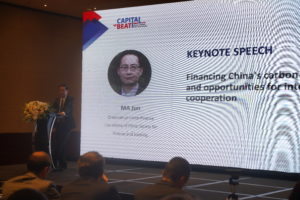
European Chamber’s Green Investment Conference
With the heavy focus on carbon neutrality and environmental protection in the 14th Five-year Plan, the European Chamber is holding a number of events in 2021 on going green. One of these events was the Green Investment Conference: Fighting Climate Change with Finance, held in Beijing and online on 19th May. Distinguished guests and participants included Marcel Haag of the Directorate-General for Financial Stability, Financial Services and Capital Markets Union (DG FISMA) of the European Commission, Jin Liqun of the Asian Infrastructure Investment Bank (AIIB) and Ma Jun of the China Society for Finance and Banking.
The conference was opened by Chamber President Jörg Wuttke, who stressed the fact that the emphasis on sustainability and the transition to green operations would create numerous business and investment opportunities, which European enterprises are already well-positioned to take advantage of.
The first keynote speech was a video address from Mr Haag, director for horizontal policies, including sustainable finance, at DG FISMA. He spoke on the latest developments in green finance from a European Union (EU) regulatory perspective. Director Haag noted that the OECD had estimated that nearly United States dollars (USD) 7 trillion would be needed in sustainable investments before 2030 to meet climate change commitments globally. He said that there is considerable interest from investors worldwide to contribute to this transition. He added: “Our task as policymakers in the field of private finance is to set the targets and provide clarity on the direction of travel, and to provide the private sector with credible and usable frameworks.” One of these frameworks will be the EU’s climate taxonomy, which aims to improve transparency in the sustainable finance market. Director Haag said, as a result, “market participants will be able to greatly reduce the resources they currently devote to the identification of sustainable investments, as the taxonomy will disseminate most of the information.” Director Haag also mentioned the International Platform on Sustainable Finance (IPSF), which brings together policymakers from 17 jurisdictions—including the EU and China—that account for around 55 per cent of global greenhouse gas emissions and almost 55 per cent of global GDP. He announced that the EU and China are working on a common grounds taxonomy under the IPSF.

The director was followed by Jin Liqun, president and chair of the AIIB, who spoke on the topic ‘AIIB: Investing in infrastructure for tomorrow’. He spoke of how the AIIB is playing its part in driving the transition to a green economy by not only rejecting investments in coal-fired energy plants or coal mines, but also by not financing coal-enabling projects, such as the building of roads to a coal mine, or the electricity infrastructure that will allow coal-fired plants to operate. President Jin urged European political and business leaders to put the resources they transfer to poorer countries into renewable energy options to show the way forward. He said that the belief that developing countries can only grow by using fossil fuels is a fallacy – there are other options. Behaviour change is important, and a new behavioural model is required. President Jin concluded by saying that: “When the wind blows, some people build walls, and some people build windmills.”

Ma Jun, chair of the Green Finance Committee of the China Society for Finance and Banking, also delivered a keynote speech to the conference. He said that while Tsinghua University has estimated that achieving carbon neutrality by 2060 will cost Chinese yuan (CNY) 100 trillion, he expects that up to CNY 500 trillion will be spent in the coming years on decarbonisation. Chair Ma said that only one per cent of loans issued in China has gone towards green financing. In the meantime, the green bond market in China was worth CNY 1.3 trillion in early 2021, having doubled year-on-year. He said the sustainable finance market in China will change in five ways:
- The taxonomy will have to change, as it had been set up to deal with pollution in Beijing when reducing PM2.5 was the priority, while carbon was not addressed. Carbon neutraility is now the priority, so the bond taxonomy has removed investments in coal-fired energy.
- The central bank is designing a methodology on calculating the carbon footprint of projects/investments. Banks will be asked to disclose the carbon emissions per unit of loans issued, so debtors will have to disclose this information to their banks.
- Incentives will have to be improved, as many carbon neutrality projects are not currently feasible. This could be achieved, for instance, by reducing loan rates for green financing, while increasing rates for ‘brown’ financing.
- New types of financial products will be made available, such as carbon neutrality bonds. There is appetite for green bonds, demonstrated by the fact that 50 per cent of all green bonds issued in China have been issued in the first half of 2021.
- Only five per cent of business is currently green; 90 per cent are still carbon emitters, and traditional banks still have to lend to them, but this financing could fund the carbon emitters’ transition to green operations.
Following the keynote speeches, there was a panel discussion on ‘Strengthening investment in green finance to support sustainable growth, increase environmental protection and implement the Paris Agreement’, with panellists from the banking and investment sectors. The panellists further highlighted the growing interest in green finance, with 700 environmental, social and governance investment funds set up across all assets in China in 2020. By the end of the year, outstanding credits were worth CNY 12 billion and bonds CNY 850 billion. Evidence has shown that while sustainable assets are more expensive in terms of investments initially, as in the first three or four months, over three or four years, these assets outperform traditional financial assets. The panellists also agreed on the importance of capital markets in the transition, not just in terms of providing financing but also in determining where the resources will go.


Recent Comments